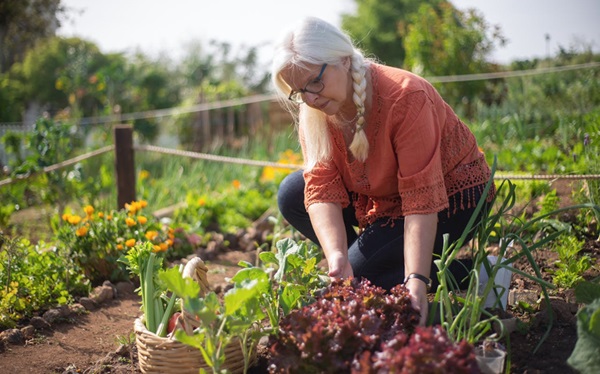Today, roughly 821 million people worldwide are considered undernourished, according to a 2023 report published by the Intergovernmental Panel on Climate Change, or IPCC. This lack of nourishment has a wide array of consequences, including stunting growth (currently impact 151 million children under five), leading to iron deficiency in millions of women and young girls, and obesity, which impacts billions.
Hunger and food security are as much about nutrition as they are about food availability in general. People need access to healthy, affordable food that meets their dietary needs and enables them to live a productive, active lifestyle to be considered food secure. Other considerations include physical proximity (the food needs to be accessible) and stability (the food needs to be consistently available).
However, it’s a misconception that just because a household has a variety of food providers nearby—fast food establishments, for example—that household is by default food secure. If the food options do not contain fresh, nutritious options that can support a healthy lifestyle when eaten consistently, it does not fall within the definition of food security.
Environmental Factors and Food Insecurity
A wide range of factors can make a person susceptible to food insecurity, including race and ethnicity, employment status, income, cost of groceries, the neighborhood in which they live, and even political policy. Systemic racism and barriers for disabled communities are two monumental issues that we won’t be tackling in today’s article but that are incredibly important to call out; to understand the actual harm that’s been done when it comes to the disproportionate lack of access to nutritious foods.
Our global, national, and local environments—the communities in which we live as well as the health of ecosystems and habitats—also play a large role in what foods are available and in what quantities. Here’s a quick breakdown of some of the most impactful ways the current state of our environment is impacting food security both in the United States and around the world.
Access to Clean Water
Unsafe drinking water poses many well-known health risks, including the spread of disease and increased malnutrition due to a lack of irrigation for farming. People need to be able to safely drink water and to use this water to grow and prepare their food. A lack of water means an increased reliance on foods lacking proper nutrients. Currently, about 2.4 billion people (and about 40% of global croplands) are in countries experiencing water stress and/or scarcity. Yet, the global demand for food and water—with our current systems still in place—is expected to grow by 50% by 2050. This is simply not sustainable and global hunger is only going to get worse as a result.
Fishing and Aquaculture
Clean, healthy oceans mean abundant fish; an incredibly important fact when it comes to food security as more than three billion people around the world rely on fish and seafood as their main source of protein. It’s currently estimated that humans catch around 200 million tons of fish every single year. Pair this with rising ocean acidity levels, dramatically increasing marine plastic pollution, and global marine habitat loss, and it’s a recipe for hunger. Fishing and aquaculture practices, when not conducted in a sustainable manner, directly lead to food insecurity.
Oil Crops and Forest Degradation
Tropical oil crops like palm, soy, cotton, and canola are referred to as “oilseed” crops and have dramatically changed both the agriculture and landscape of the tropics over the past twenty years. As demand continues to skyrocket, more and more savanna lands and tropical forests are being cleared to make way for oilseeds, and at the detriment of many critical ecosystems. Soil degradation, water usage in areas already experiencing water scarcity, and increased pollution are all examples of this. The use of oilseeds in the creation of biofuels also impacts the products’ demand and increases cost, decreasing food security as a result.
Crop and Livestock Systems
Growing food and raising livestock are both resource intensive activities that directly impact lands, water supplies, and hunger. How we grow our food influences the land on which we grow it, which in turn affects how much food we grow. While today’s monocropping practices might be good for a farmer’s bottom line (right now), the environmental consequences will be detrimental–they already are.
Monocropping leads to nutrient-depleted soils, which require significantly more water and more fertilizer to produce a healthy crop. And yet, much of what’s grown in the heartland of the U.S. is food that directly translates to animal feed, not human food. Fresh fruits and vegetables are primarily grown on the coasts and have to be shipped to other states, increasing the price of these more nutrient-dense foods and making them less accessible for all people.
Food Security and Climate Change
The production of an extreme excess of carbon dioxide and other greenhouse gases because of human activities like industry, agriculture, and transportation has led us to where we are now—a very quickly warming planet (1.1°C so far) and food systems that are unable to adapt. As global average temperatures continue to increase with longer and more intense heatwaves in regions across the planet, so will instances of extreme weather, such as drought. Scientists estimate there could be as many as 1.5 billion climate refugees by 2050 due to climate disasters as well as an inability to adapt and meet community needs at the same rate as extreme environmental changes—and this very much includes food.
Increasing temperatures, changes to precipitation, and extreme weather events all impact crop production. The result? Much higher food costs, especially for basics like wheat that billions of people rely on every day. Those crops that are produced are also likely to have a much lower nutritional quality.
“Climate change can affect food availability, access, utilization, and the stability of each of these over time.”
USDA
When it comes to who will be the most affected by these changes, the answer is those who are already food insecure or at a much higher risk of being so, including low-income households, communities of color, women, and children.
So, what do we do about it?
Environmental Solutions to Tackle Food Insecurity
There is no one right answer when it comes to improving both food security and our environment. It’s going to require the implementation of many solutions that work together to address some of today’s largest environmental and systemic challenges. A great place to start is by introducing climate-adaptive and regenerative farming on a much wider scale. By improving how we work with the land, we can enrich our soil and improve pollination while simultaneously increasing crop production.
But simply having more food isn’t the sole answer to the problem. We must ensure that everyone has access to these nutritious foods, and to do this, we must address food waste. In the United States alone, more than one-third of the food supply goes to waste. That’s an embarrassing amount of food that’s not helping to feed our citizens and is, instead, sitting in a landfill, contributing to methane gas production and making our climate worse. Taking a closer look at our food systems and tackling the causes of this waste (e.g., transportation) can help us streamline our food production and improve overall accessibility.
Decreasing the overall production and consumption of meat, an extremely resource-intensive category of foods, is another—though perhaps less popular—option. By scaling back meat consumption and incorporating more sustainable methods of grazing and livestock rearing, we can significantly reduce the carbon footprint of the agricultural sector while putting a stronger emphasis on plant-derived proteins, which are often more accessible than their animal-based counterparts.
And, finally, education. Specifically, educating women and girls plays a huge role in food security and environmental health around the world. Particularly in the developing world, women play an integral role in food security and agriculture, producing 60% to 80% of food in developing countries (and about 50% of the world’s food production). Yet, gender inequalities—like a lack of education—prevent women from tapping into their full potential. By expanding education for women and girls, we can not only even the playing field between men and women, but expand opportunities for nutritious, healthy food access and production.
“If women are allowed to have equal access to education, various pieces of the food security jigsaw will fall into place...Household spending on nutrition will increase, child health outcomes will improve, and social systems will be redesigned – for women, by women – to deliver support with the greatest multiplier effects.”
Olivier De Schutter, United Nations Special Rapporteur




